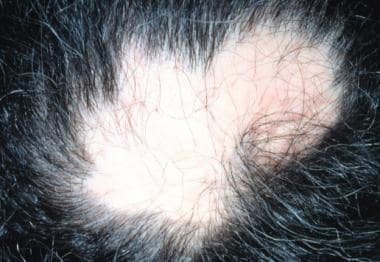History
The typical pseudopelade of Brocq patient is surprised to discover discrete asymptomatic areas of scalp hair loss (most commonly affecting the vertex and parietal scalp [2] ). In many patients, pseudopelade of Brocq is slowly progressive (ie, new areas of alopecia develop over a period of months to years). However, pseudopelade of Brocq may worsen in spurts, with periods of activity followed by periods of dormancy. This is distinctly different from the slow but steady disease progression seen in several other forms of scarring alopecia. [13, 14] As the condition progresses, patients with pseudopelade of Brocq may become emotionally distressed with the lack of treatment options and uncertain etiology of their condition. Disease progression in pseudopelade eventually ends spontaneously.
Physical Examination
Lesions of pseudopelade are randomly distributed, irregularly shaped, and often cluster in patches on the scalp. Cases with exclusive crown or vertex involvement actually may represent examples of burnt-out central cicatricial alopecia. [15] The individual lesion is hypopigmented (porcelain white is the classic description) and slightly depressed (atrophic). Pseudopelade of Brocq lesions often are shaped irregularly, as opposed to the round or oval patches usually seen in alopecia areata and most cases of central cicatricial alopecia.
 Irregularly shaped patch of scarring alopecia on the occiput of a middle-aged white woman. This asymptomatic lesion was first discovered by the patient's hairdresser.
Irregularly shaped patch of scarring alopecia on the occiput of a middle-aged white woman. This asymptomatic lesion was first discovered by the patient's hairdresser.
Typical of many forms of scarring alopecia, a few isolated hairs may remain within an otherwise smooth, shiny, denuded patch. Rare cases of pseudopelade have been reported to affect the beard or eyebrows in addition to the scalp. [16, 17] Include the nails and oral mucosa, as well as the skin, in the physical examination to exclude evidence of other forms of scarring alopecia. Pseudopelade of Brocq is a diagnosis of exclusion.
Dermatoscopic examination
An absence of follicular ostia is noted with dermoscopy. [18]
-
Irregularly shaped patch of scarring alopecia on the occiput of a middle-aged white woman. This asymptomatic lesion was first discovered by the patient's hairdresser.



